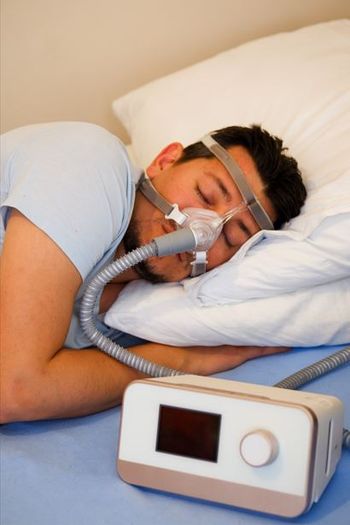
Holocaust Survivor: An Incidental Finding
An 87-year-old woman who recently moved to an assisted living facility from her home is seen for evaluation of facial edema and erythema after a bee or wasp sting sustained 2 days earlier. Patient denies pain, pruritus, or visual changes.
HISTORY
An 87-year-old woman who recently moved to an assisted living facility from her home is seen for evaluation of facial edema and erythema after a bee or wasp sting sustained 2 days earlier. Patient denies pain, pruritus, or visual changes. She took one dose of diphenhydramine shortly after the event and has noticed that the edema, which affected primarily the right side of the face, near the sting, has improved.
PHYSICAL EXAMINATION
Ambulatory, well-dressed woman in no acute distress. She is alert and pleasant, with clear but rambling speech consistent with her known mild dementia. Vital signs are stable. Skin is slightly warm; erythematous flat area periorbitally and extending down the right cheek. Erythema faintly crosses the bridge of the nose and is minimal on the left side of the face. Left forearm with the tattoo illustrated.
"WHAT'S YOUR DIAGNOSIS?"
ANSWER: HOLOCAUST CAMP SURVIVOR
Figure – Patient shows very little facial wrinkling. Expression is normal and friendly. Remnants of bee sting–related changes are minor, and the cellulitis that followed has cleared with antibiotics.
The crude tattoo on this woman's forearm constitutes a "human label" that includes a unique identification number used in a concentration camp. The same kind of mark was made, often even less neatly, on all other inmates of her camp. The "A" represents Auschwitz, the infamous work and death camp. The Nazis' "final solution" was designed to kill all Jews worldwide.1 This woman was at Auschwitz for part of the Holocaust, and then was moved to another camp, Maidanek.
As one can see, the patient has retained the capacity to smile (
RECOGNIZING THE SURVIVOR
All Holocaust survivors bear profound psychic scars. For many, the experience was so painful that they do not mention it spontaneously. Some cognitively and (otherwise) affectively intact persons even explicitly deny that they were in the camps, because they cannot bear any reminder, or because their perceptions have been altered beyond reach of reality through psychological aftereffects. Thus, sometimes a Holocaust camp survivor will be recognized as such only from the distinct physical sign of the tattoo. Because there is no other large-scale source of this human labeling, this type of tattoo appears pathognomonic.
You might suspect factitious tattooing if the patient were younger than 70 years: children were slaughtered almost without exception in the camps, where the notorious "selections" (of prisoners who would go to the gas chamber) were based on the lack of ability to perform manual labor in support of the Nazi war effort. As a result, virtually no camp survivors are younger than 75 years today, 60 years after the liberation.
The survivor is likely to be Jewish; but Hitler incarcerated Gypsies and Polish Christians, as well as homosexuals and members of other groups, many thousands of whom were murdered. A few persons converted later in life, so present religious affiliation is not a perfect indicator of susceptibility.
There are Holocaust survivors who do not bear this physical mark. A minute number may have had the tattoos removed. Others never fell into the hands of the Nazis, as was the case with a nonagenarian whom one of us cared for and who had lived in the deep woods during the war. The absence of this sign should not make you discount the history. The further harm done to the victim by Holocaust deniers is severe; it is tolerable neither at an individual nor at a societal level. This phenomenon recalls the "second rape" effect on a victim of sexual assault who is not taken seriously.
SPECIAL FACETS OF MEDICAL CARE
Swartz's textbook offers insights about interviewing survivors and about psychological aspects of their situation.2 The fear of becoming sick is even greater in this population than in other old persons; illness usually meant rapid death because of the lack of therapy or because it rendered them unfit for work-and therefore likely to be in the next selection for the gas chamber. There were, however, extraordinary recoveries as well. A little-known footnote to this horror is that some of the death camps had hospitals so that the victims could be nursed back to health before consignment to the gas chamber.3-5
The effects of loss of control and loss of dignity, against which there was almost no protection in the camps, remain paramount in the behavior and thought of survivors, even more perhaps than in age-matched controls. The history that one can elicit may include vivid nightmares, covert or overt depression, delayed stress reactions, and attacks of anxiety or panic.
Questions about family history may precipitate tears, since in almost all cases, many members of survivors' families were killed, along with sweethearts and friends. It is common for a survivor to be the only family member left. Survivor guilt is common, centering on the unanswerable question, "Why did I survive while my wife (children, husband, sibling, parent) died?"
Besides these affective and psychological effects, somatic symptoms are common, especially gastrointestinal complaints and chest pain. Two most telling vignettes about the medical care of survivors focus on the interweaving of affective and medical components.6,7 In one situation, recognition begins with a question about the meaning of the numbers and letters on the skin, the significance of which a resident physician has not understood. In the other, this sign is missed by the least sensitive member of the health care team when a man is admitted with "nonorganic" chest pain. The patient ultimately benefits enormously from connecting as a human being with an intuitive, caring, and insightful intern who helped him, over the course of several days, to review his painful life story.
PSYCHIATRIC AND GERIATRIC ISSUES
Holocaust survivors are reaching old age. With aging may come physical frailty and cognitive decline, which may exacerbate traumatic memories.8 Aging of survivors is associated with more depression, anxiety, post-traumatic stress disorders, physical disorders, life loss, and loss of function than in unselected older persons, with attendant psychological distress, decreased quality of life, and increased risk of suicide.9,10 A smaller group of survivors reports flashbacks and psychogenic amnesia.11
Chronic stress may predispose survivors to ineffective coping as they age. The survivor's recounting his or her story as part of preserving societal awareness of the Holocaust may help that person cope and is an important component of treatment.11 Holocaust survivors are a heterogenous group, each with a unique story and coping mechanism. Caring for Holocaust survivors confers special challenges. Some health care workers find that survivors may be especially demanding because they believe that they are entitled to better or preferential treatment.12
ARE THERE ANALOGOUS SURVIVORS OF OTHER HELLS?
The answer, tragically, is yes, and for some we have physical signs that help us to recognize them. For others, only our awareness of political and military history, and of crimes against humanity, alerts us to the special needs of these victims.
Even though the number of Holocaust survivors is decreasing, survivors of newer tragedies are emerging. A review of late-life effects of prior psychological trauma revealed that such symptoms as disruptions of sleep and dreaming, intrusive memories, impairment of trust, avoidance of stressors, and heightened vulnerability to various types of age-associated retraumatizations are present in all groups who have encountered psychological trauma earlier in life-not just Holocaust survivors.13
A Bosnian survivor of "ethnic cleansing" may look no different from anyone else, but may have been raped as a matter of government "policy" or had multiple family members massacred in Srebrenica.
If one meets a Sierra Leonean or a Rwandan who is missing most of one or both arms, the odds are that this person was hacked as part of the violence perpetuated by both insurgent and established forces. It is far less likely that a more normal cause-such as a motor vehicle crash or therapeutic amputation for a sarcoma-was involved. Unless one recognizes that an immigrant's name is Cambodian rather than Laotian, one may not realize that the patient hails from a country where a dictator killed more than 1 million of the 7 million inhabitants 1 generation ago. As long as empowered segments of the human race continue to maim and kill, clinicians will continue to have to care for survivors.
HOW CAN WE COPE?
It is very difficult to grasp the random violence that humans do to one another-drive-by shootings, for instance-and harder still to comprehend prejudicial widespread murder, as for instance of Armenians by Turks, almost 90 years ago, or of Americans by terrorists flying into the World Trade Center. Sometimes history books can help, but the insights in literature may be more immediate and more digestible for us.14 Given how much pain and suffering each clinician must observe and cope with in a typical workday, it is likely that only small and rare doses of this literature will be manageable.
Regardless of the extent of our factual knowledge, we may be consumed with resentment and rage at the perpetrators. Or we can seek a small counterweight, in recognizing that our mission with these victims is to embody the opposite kind of personhood: decent, helpful and, in a word, human. Only then can we find some measure of comfort, for the profession that each of us is privileged to practice accords us the means to help, heal, soothe, and undo some harm. In a Hebrew phrase that applies to all people of goodwill regardless of their religion, we have a small opportunity for tikkun olam-that is, to repair the world.
WRAP-UP
This patient reminded us vividly with several remarks that awareness of her past shaped the person that she is. Her personality and behavior showed that she well remembered what she had lived through, but also had the work of living today foremost in her feelings. We felt most gratified to see her recover uneventfully from an acute problem with a bit of our help and care. Had we administered prednisone, we would have proudly ascribed the rapid resolution of our patient's conditions to its effects.
Schneiderman H, Johnson S. The mark of a survivor of a Nazi death camp. CONSULTANT. 2005;45:1213-1217
References:
REFERENCES:
1.
Gilbert M.
The Second World War: A Complete History.
New York: Henry Holt and Company; 1989.
2.
Swartz, MH.
Textbook of Physical Diagnosis: History and Examination.
4th ed. Philadelphia: WB Saunders Co; 2004:36-37.
3.
Stabholz T.
Seven Hells.
Grunblatt J, Grunblatt HR, translators. New York: Holocaust Library; 1991.
4.
Levi P.
Survival in Auschwitz.
New York: Collier Books; 1958.
5.
Wiesel E.
Night.
New York: Bantam Books; 1982.
6.
Yost D. A piece of my mind. The mark of a survivor.
JAMA.
1988;259:578.
7.
Sontag SJ. A piece of my mind. A piece of her heart.
JAMA.
1988;259: 1071-1072.
8.
Ehrlich MA. Health professionals, Jewish religion and community structure in the service of the aging holocaust survivor.
Arch Gerontol Geriatr.
2004;38: 289-295.
9.
Barak Y, Aizenberg D, Szor H, et al. Increased risk of attempted suicide among aging holocaust survivors.
Am J Geriatr Psychiatry.
2005;13:701-704.
10.
Schreiber S, Soskolne V, Kozohovitch H, Deviri E. Holocaust survivors coping with open heart surgery decades later: posttraumatic symptoms and quality of life.
Gen Hosp Psychiatry.
2004;26:443-452.
11.
Yehuda R, Elkin A, Binder-Brynes K, et al. Dissociation in aging Holocaust survivors.
Am J Psychiatry.
1996;153:935-940.
12.
Leonhard B. Nursing care for elderly Holocaust survivors. Experiences of Israeli nurses as related to their own life stories [in German].
Pflege.
2003; 16:31-39.
13.
Sadavoy J. Survivors. A review of the late-life effects of prior psychological trauma.
Am J Geriatr Psychiatry.
1997;5:287-301.
14.
Presser J.
Breaking Point: A Factual Novel.
Cleveland: World Publishing Company; 1958.
Newsletter
Enhance your clinical practice with the Patient Care newsletter, offering the latest evidence-based guidelines, diagnostic insights, and treatment strategies for primary care physicians.

















































































































































































































































































